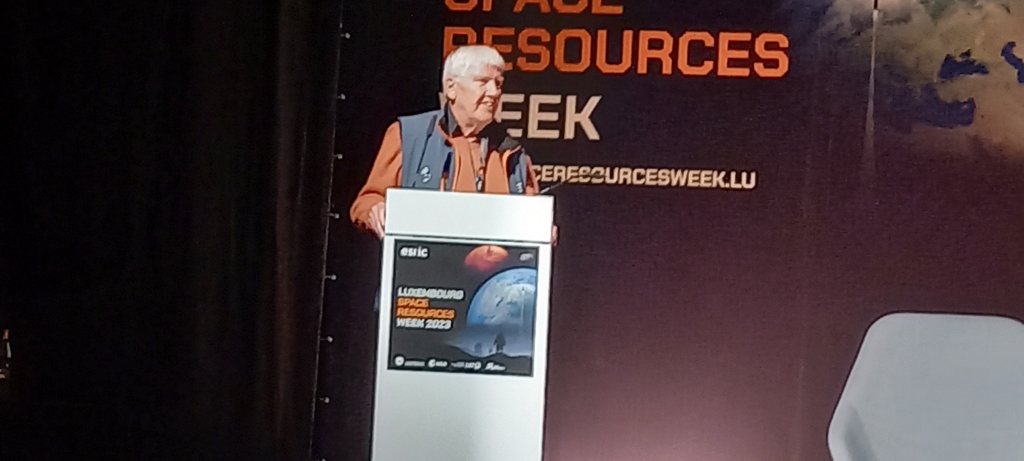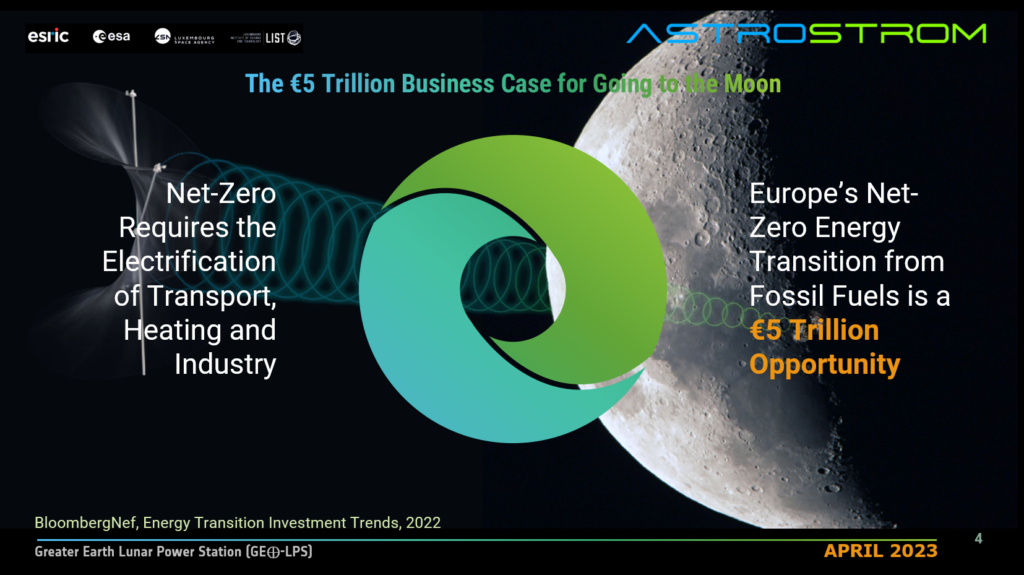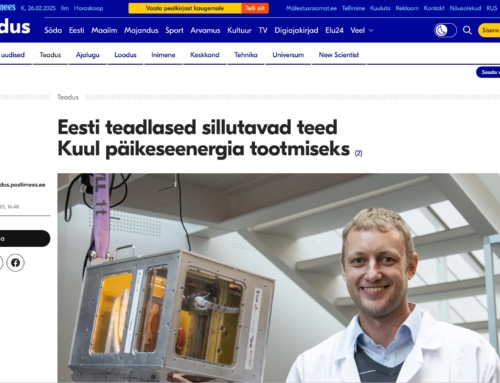Astrostrom presented initial results of its ESA funded OSIP feasibility study: Greater Earth Lunar Power Station (GE⊕-LPS) at the Luxembourg Space Resources Week 2023 on April 19

Arthur Woods, CEO of Astrostrom GmbH, speaking at the 2023 Luxembourg Space Resources Week
In the context of ESA’s open call for proposals “Clean Energy from Space” [1] which sought novel ideas related to Space-Based Solar Power (SBSP) systems, Astrostrom GmbH has been investigating the feasibility of the “Greater Earth Lunar Power Station” (GE⊕-LPS) designed to provide power from space to operations on the lunar surface. This is a crewed facility in lunar orbit that will be constructed primarily from lunar materials. If shown to be both feasible and scalable, manufacturing future Solar Power Satellite (SPS) components from lunar materials and transporting these to geostationary orbit (GEO), would be a means to avoid the need to launch hundreds or thousands of massive SPSs from the surface of the Earth in order to supply environmentally benign, baseload electricity to Earth. During the study, ESA announced the SOLARIS program [2] to explore the feasibility and potential of SBSP to provide clean energy to Earth, for which funding was approved at the ESA Council at Ministerial Level in November 2022.
The GE⊕-LPS is a is a concept that advances lunar development in order to contribute to terrestrial energy production. The construction of GE⊕-LPS with lunar materials requires developing facilities on the Moon for automated mining and manufacturing processes. The materials required for GE⊕-LPS include cast basalt and basalt fibre for the structural elements. Silicon, ilmenite and especially pyrite are considered for semiconductors and photovoltaics, whereas metals such as iron and aluminium will serve for the electrical connections. The establishment of industrial-scale beneficiation and processing plants will provide access to several other materials, which may become valuable to other users in the cislunar region. In addition to small amounts of Helium-3, a vast amount of oxygen will be produced as a by-product which can be used in life support systems and as rocket propellant, thereby creating business cases for new cislunar enterprises.
GE⊕-LPS is being designed to provide plentiful electrical power for lunar activities; serve as a gateway between Earth and Moon operations; and be a prototype for future space settlements and tourism in cislunar space. As it is foreseen that the energy production functions of the GE⊕-LPS concept can be scaled to any dimension, larger versions could be positioned in Earth orbit to provide much needed clean, continuous solar electricity for terrestrial users. Driven by the ever-growing energy market on Earth, a two-planet economic system will emerge, which will dramatically lower the costs of transporting people and resources between LEO and the lunar surface, and accelerate the growth of many new cislunar businesses.
As such, the GE⊕-LPS project unites the aims of lunar development with widely shared aspirations for expanded space activities, while also addressing the critical energy and environmental needs of human civilization on Earth.

Astrostrom has identified three key technologies. All are technically feasible and under development today.
- The Lunar Space Elevator (LSE) can be constructed from known materials and technologies. It would consist of a cable from the Moon’s surface to the Earth-Moon Lagrange point 1 and then extending almost to geostationary orbit. A mature LSE would become an economic Earth-Moon transportation system.
- Monograin layer (MGL) solar cells are a single-crystalline type of solar cell that do not require wafer technology. Under development at the Tallinn Technical University in Estonia and at Crystalsol GmbH in Vienna, Austria, these photovoltaics could be manufactured from lunar pyrite.
- Basalt fibre production would create a base construction material on the Moon. Cast basalt and basalt 3-D printing are mature technologies that can be used for lunar construction.

Bloomberg and other organizations have estimated that the European energy transition
will be a 5 trillion Euro investment opportunity – or more.

We estimate that just 2% of the cost of the European energy transition – € 99 billion or less – would be necessary to install the infrastructure needed to begin manufacturing Solar Power Satellite components on the Moon.
Can you think of a better reason to go to the Moon?
References:
[1] ESA: Supported Technology Developments
https://www.esa.int/Enabling_Support/Space_Engineering_Technology/SOLARIS/ESA-supported_technology_developments
[2] ESA: Solaris https://www.esa.int/Enabling_Support/Space_Engineering_Technology/SOLARIS
Acknowledgement: this work has been carried out under ESA contract: ESA STAR 2-1789/21/NL/GLC/ov





